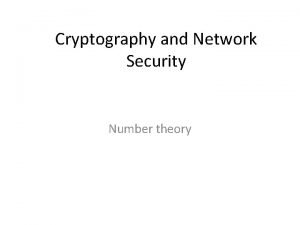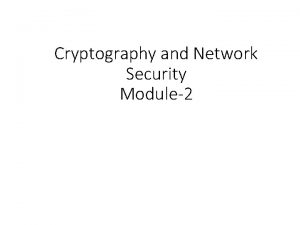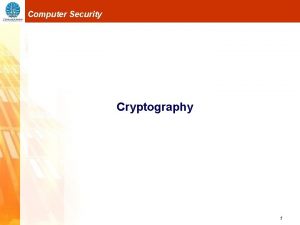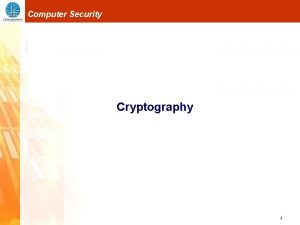Cryptography and Network Security Chapter 8 Chapter 8














- Slides: 14

Cryptography and Network Security Chapter 8

Chapter 8 – Introduction to Number Theory The Devil said to Daniel Webster: "Set me a task I can't carry out, and I'll give you anything in the world you ask for. " Daniel Webster: "Fair enough. Prove that for n greater than 2, the equation an + bn = cn has no non-trivial solution in the integers. " They agreed on a three-day period for the labor, and the Devil disappeared. At the end of three days, the Devil presented himself, haggard, jumpy, biting his lip. Daniel Webster said to him, "Well, how did you do at my task? Did you prove theorem? ' "Eh? No. . . no, I haven't proved it. " "Then I can have whatever I ask for? Money? The Presidency? ' "What? Oh, that—of course. But listen! If we could just prove the following two lemmas—" —The Mathematical Magpie, Clifton Fadiman

Prime Numbers • prime numbers only have divisors of 1 and self – they cannot be written as a product of other numbers – note: 1 is prime, but is generally not of interest • eg. 2, 3, 5, 7 are prime, 4, 6, 8, 9, 10 are not • prime numbers are central to number theory • list of prime number less than 200 is: 2 3 5 7 11 13 17 19 23 29 31 37 41 43 47 53 59 61 67 71 73 79 83 89 97 101 103 107 109 113 127 131 137 139 149 151 157 163 167 173 179 181 193 197 199

Prime Factorisation • to factor a number n is to write it as a product of other numbers: n=a x b x c • note that factoring a number is relatively hard compared to multiplying the factors together to generate the number • the prime factorisation of a number n is when its written as a product of primes – eg. 91=7 x 13 ; 3600=24 x 32 x 52

Relatively Prime Numbers & GCD • two numbers a, b are relatively prime if have no common divisors apart from 1 – eg. 8 & 15 are relatively prime since factors of 8 are 1, 2, 4, 8 and of 15 are 1, 3, 5, 15 and 1 is the only common factor • conversely can determine the greatest common divisor by comparing their prime factorizations and using least powers – eg. 300=21 x 31 x 52 18=21 x 32 hence GCD(18, 300)=21 x 31 x 50=6

Fermat's Theorem • ap-1 = 1 (mod p) – where p is prime and gcd(a, p)=1 • also known as Fermat’s Little Theorem • also ap = a (mod p) • useful in public key and primality testing

Euler Totient Function ø(n) • when doing arithmetic modulo n • complete set of residues is: 0. . n-1 • reduced set of residues is those numbers (residues) which are relatively prime to n – eg for n=10, – complete set of residues is {0, 1, 2, 3, 4, 5, 6, 7, 8, 9} – reduced set of residues is {1, 3, 7, 9} • number of elements in reduced set of residues is called the Euler Totient Function ø(n)

Euler Totient Function ø(n) • to compute ø(n) need to count number of residues to be excluded • in general need prime factorization, but – for p (p prime) – for p. q (p, q prime) ø(pq) = p-1 =(p-1)x(q-1) • eg. ø(37) = 36 ø(21) = (3– 1)x(7– 1) = 2 x 6 = 12

Euler's Theorem • a generalisation of Fermat's Theorem • aø(n) = 1 (mod n) – for any a, n where gcd(a, n)=1 • eg. a=3; n=10; ø(10)=4; hence 34 = 81 = 1 mod 10 a=2; n=11; ø(11)=10; hence 210 = 1024 = 1 mod 11

Miller Rabin Algorithm • a test based on Fermat’s Theorem • algorithm is: TEST (n) is: 1. Find integers k, q, k > 0, q odd, so that (n– 1)=2 kq 2. Select a random integer a, 1<a<n– 1 3. if aq mod n = 1 then return (“maybe prime"); 4. for j = 0 to k – 1 do jq 2 5. if (a mod n = n-1) then return(" maybe prime ") 6. return ("composite")

Probabilistic Considerations • if Miller-Rabin returns “composite” the number is definitely not prime • otherwise is a prime or a pseudo-prime • chance it detects a pseudo-prime is < 1/4 • hence if repeat test with different random a then chance n is prime after t tests is: – Pr(n prime after t tests) = 1 -4 -t – eg. for t=10 this probability is > 0. 99999

Prime Distribution • prime number theorem states that primes occur roughly every (ln n) integers • but can immediately ignore evens • so in practice need only test 0. 5 ln(n) numbers of size n to locate a prime – note this is only the “average” – sometimes primes are close together – other times are quite far apart

Discrete Logarithms • the inverse problem to exponentiation is to find the discrete logarithm of a number modulo p • that is to find x such that y = gx (mod p) • this is written as x = logg y (mod p) • if g is a primitive root then it always exists, otherwise it may not, eg. x = log 3 4 mod 13 has no answer x = log 2 3 mod 13 = 4 by trying successive powers • whilst exponentiation is relatively easy, finding discrete logarithms is generally a hard problem

Summary • have considered: – prime numbers – Fermat’s and Euler’s Theorems & ø(n) – Primality Testing – Chinese Remainder Theorem – Discrete Logarithms
 Wireless security in cryptography and network security
Wireless security in cryptography and network security Cryptography and network security 6th edition
Cryptography and network security 6th edition Introduction to network security and cryptography
Introduction to network security and cryptography Number theory in network security
Number theory in network security Firewall base layer
Firewall base layer Authentication in cryptography and network security
Authentication in cryptography and network security Three classes of intruders in network security
Three classes of intruders in network security Primitive root
Primitive root Cryptography and network security 6th edition pdf
Cryptography and network security 6th edition pdf Pearson cryptography and network security
Pearson cryptography and network security Source
Source Cryptography and network security 4th edition
Cryptography and network security 4th edition Euler's theorem in cryptography and network security
Euler's theorem in cryptography and network security Multiplicative inverse
Multiplicative inverse Digital signature in cryptography and network security
Digital signature in cryptography and network security



























